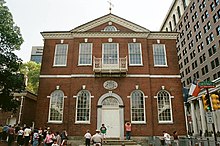4th United States Congress
| 4th United States Congress | |
|---|---|
|
3rd ←
→ 5th
|
|

Congress Hall (2007)
|
|
| March 4, 1795 – March 4, 1797 | |
| Senate President | John Adams (F) |
| Senate Pres. pro tem |
Henry Tazewell (F) Samuel Livermore (F) William Bingham (F) |
| House Speaker | Jonathan Dayton (F) |
| Members | 30-32 (two additions)(with 0-4 vacancies) Senators 106-107 (one additions)(with 0-8 vacancies) Representatives 1 Non-voting members |
| Senate Majority | Federalist |
| House Majority | Democratic-Republican |
| Sessions | |
|
Special: June 8, 1795 – June 26, 1795 1st: December 7, 1795 – June 1, 1796 2nd: December 5, 1796 – March 3, 1797 |
|
The Fourth United States Congress was a meeting of the legislative branch of the United States federal government, consisting of the United States Senate and the United States House of Representatives. It met at Congress Hall in Philadelphia, Pennsylvania from March 4, 1795 to March 4, 1797, during the last two years of George Washington's Presidency. The apportionment of seats in the House of Representatives was based on the First Census of the United States in 1790. The Senate had a Federalist majority, and the House had a Democratic-Republican majority.
This was the first Congress to have organized political parties. Details on changes are shown below in the "Changes in membership" section.
This list is arranged by chamber, then by state. Senators are listed by class, and Representatives are listed by district.
Senators were elected by the state legislatures every two years, with one-third beginning new six-year terms with each Congress. Preceding the names in the list below are Senate class numbers, which indicate the cycle of their election. In this Congress, Class 1 meant their term ended with this Congress, requiring re-election in 1796; Class 2 meant their term began in the last Congress, requiring re-election in 1798; and Class 3 meant their term began in this Congress, requiring re-election in 1800.
All representatives were elected statewide on a general ticket.
Both representatives were elected statewide on a general ticket.
(2 Democratic-Republicans)
All representatives were elected statewide on a general ticket.
...
Wikipedia
